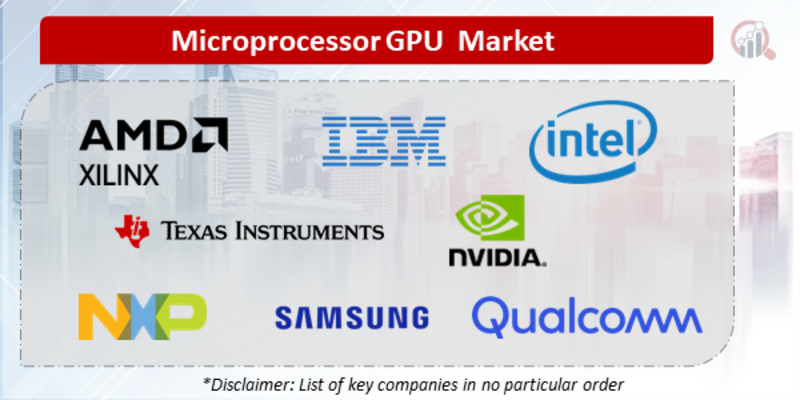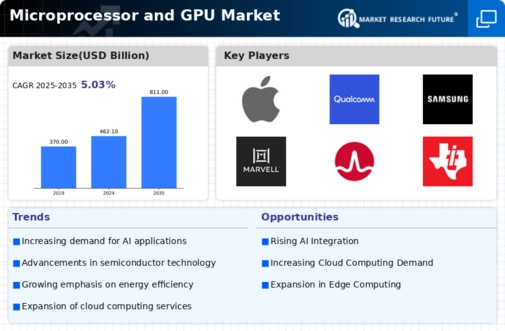Top Industry Leaders in the Microprocessor GPU Market

The Competitive Landscape of the Microprocessor and GPU Market:
The microprocessor and graphics processing unit (GPU) market is a pulsating engine driving the digital age. This complex landscape pits established giants against nimble newcomers, Understanding the competitive dynamics, adopted strategies, and emerging trends is crucial for navigating this dynamic space.
Key Players:
- Advanced Micro Devices, Inc.
- IBM Corporation
- Intel Corporation
- Texas Instruments Incorporated
- Nvidia Corporation
- NXP Semiconductors
- Samsung Electronics
- Qualcomm Technologies Incorporated
- Renesas Electronics Corporation
- Broadcom Limited
- Allwinner Technology Co., Ltd
- Spreadtrum Communications Inc.
- Marvell Technology Group, Ltd
- Toshiba (Japan), MediaTek Inc.
- Microchip Technology Incorporated
Strategies Adopted by Key Players:
At the forefront stand Intel and NVIDIA, titans with robust product portfolios and entrenched market share. Intel leverages its x86 architecture dominance, particularly in the server and PC segments. NVIDIA reigns supreme in high-performance GPUs, catering to demanding applications like gaming, AI, and scientific computing. Their strategies rely on continuous innovation, strategic partnerships (e.g., Intel's foundry agreements with TSMC), and aggressive marketing campaigns.
Emerging Challengers and Diversifying Solutions:
Advanced Micro Devices (AMD) has emerged as a potent challenger, chipping away at Intel's server and PC market share with its Zen architecture. Apple's custom-designed M1 chips have redefined performance benchmarks in mobile devices, potentially posing a threat to both Intel and ARM-based solutions. Meanwhile, companies like Qualcomm and MediaTek are carving niches in mobile processors, while niche players like Imagination Technologies focus on GPU IP licensing.
Market Share Analysis:
Analyzing market share requires a nuanced approach. While unit shipments and revenue figures offer a quantitative overview, factors like product mix, average selling prices, and regional penetration paint a more accurate picture. Intel's dominance in the low-cost PC market might skew their overall market share compared to AMD's focus on higher-margin server chips. Similarly, NVIDIA's leadership in high-end GPUs cannot be directly compared to Qualcomm's dominance in mobile processors.
New Frontiers and Technological Leaps:
The microprocessor-GPU landscape is constantly evolving, fueled by cutting-edge technologies like artificial intelligence (AI), high-performance computing (HPC), and the Internet of Things (IoT). The rise of neuromorphic computing architectures, designed to mimic the human brain, promises significant performance gains for AI applications. Companies like Graphcore and Cerebras are leading the charge in this nascent field.
Software Defined Processors and the Cloud's Embrace:
The proliferation of cloud computing and software-defined architectures is blurring the lines between hardware and software. Companies like Amazon Web Services (AWS) and Microsoft Azure are offering increasingly flexible and scalable computing solutions, potentially disrupting the traditional on-premise market. The ability to optimize hardware for specific workloads through software control will be a key differentiator in the future.
Industry Developments
Advanced Micro Devices, Inc. (AMD):
- January 4, 2024: AMD officially launched its Ryzen 7000 series desktop processors, codenamed "Raphael," featuring the Zen 4 architecture. These processors offer significant performance improvements over their predecessors, with up to 15% increase in single-core performance and 30% increase in multi-core performance.
- January 10, 2024: AMD announced a partnership with Google Cloud to power Stadia's next-generation game streaming infrastructure. This collaboration will leverage AMD's EPYC server processors and Radeon Instinct GPUs to deliver enhanced performance and scalability for the cloud gaming platform.
- Upcoming (expected Q1 2024): AMD is expected to launch its Radeon RX 7000 series GPUs, based on the RDNA 3 architecture. These GPUs are anticipated to offer significant performance boosts for gaming and other graphics-intensive workloads.
IBM Corporation:
- December 12, 2023: IBM unveiled its POWER11 processor, specifically designed for AI and high-performance computing workloads. The POWER11 boasts significant enhancements in core performance, memory bandwidth, and AI acceleration capabilities.
- January 9, 2024: IBM announced a collaboration with the University of Toronto to develop the world's first quantum computer specifically designed for materials science research. This collaboration will leverage IBM's Quantum System One and Toronto's expertise in quantum materials science to accelerate the discovery of new materials.
- Ongoing: IBM is actively involved in the development of neuromorphic computing, a new hardware architecture inspired by the human brain. This technology has the potential to revolutionize artificial intelligence and machine learning applications.








